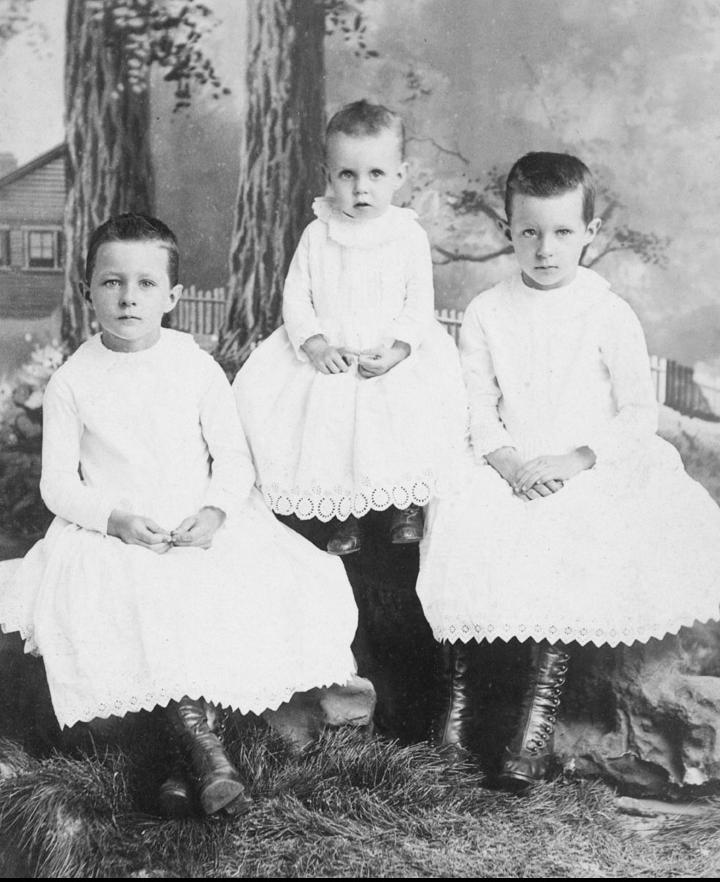
American Boy Dresses: Ages--9 Year Olds

Figure 1.--This portait comes from internet without any provenance. It is clearly a cabinet card studio portait, but we have absolutely no information about it, not even the studio and city as we do not have a scan of the entire card showing the mount. The children all look like boys although they are not identified. We would say that they are about 1-9 years of age. The studio background suggests a rural or small town scene. We suspect that this a touch of nostalgia rather than a depiction of local scenery. The boys may have well been a city family. Unfortunately we know nothing about the vfamily. We can only think that mothrv for some reason dcided omdelay breeching. They all wear virtually identical long, white dresses. The dresses all have ruffs which on the older boys are difficult to see because they are white like dress. They also have shirt-like sleeves. The only difference we can se is that the baby has a slightly different eyelet lace trim at the dress hem. The clothing is so basic that without the cabinet card mount, the portrait is difficult to date. We would guess it was taken in the 1880s, but the early-90s is possible. By thelte 90s we see fewer boys still wearing dresses, including younger boys. So such older boys earing dressess seems unlikely.
|
|
Every year beyond age 6 years we see fewer and fewer boys wearing dresses. This is clear from available school photography which becomes abailable from the late-19th century. We do not see boys wearing dresses to school even at age 6 years. This can clearly be seen in the photographic record. Unfortunately many available portraits are not identified or the age of the children specifed. So we are often left to assess the availabe images as best as possible. But we can estimate ages to within a year or at least 2 years. These images of school age boys wearing dresses raise a range of questions. We know that they were not sent to school as we do not see them in school portraits. So they were educated at home bby their parents (presumably mother) or a tutor. This means almost surely that the family was somewhat afflunt. Here the tremendous economic success of the United States in the late-19th century may have been a factor. This certainly increased the number of families with the wearwithall to keep chool age children at home. The relative prevalence, however, is another matter as the number of images in the first half of the 19th century is so limited. And we suspect they were mostly city children, although this needs to be confirmed. We believe that breeching was not partial so these boys did not have pants outfits they wore for some occassions. Very few boys were still wearing dresses, but the photographic record clearly shows that a few did. Here we have an example, although we have to rely on estimating ages and gender (figure 1). Quite a few of images are white dresses. And here the boys wearvery plain long sleeve white dresses. Unfortunately we only have a few photographic images and for the images we have found no family history.
A reader asks, "Well I think it is the case that some children were isolated, I think by mother who dressed them as you say according to their personal taste. We know this because children did not come to school in dresses. No whether they had two sets of clothes, I doubt. I have never heard of this and even in the 19th century I think the boys would have resisted wearing skirts once breeched. I think the portraits are accurate depictions as to how the boys were dressed and not just for the portrait. Unfortunately I have little information to go on, only the photographic record, " Could it be that some families isolated their children and dressed them to their personal taste but dressed then conventionally when in public. Maybe the boys have been dressed this way for the photographs." We think it is the case that some children were isolated, I think by mother who dressed them as you say according to their personal taste. We know this because children did not come to school in dresses. No whether they had two sets of clothes, I doubt. I have never heard of this and even in the 19th century I think the boys would have resisted wearing skirts once breeched. Boys were more compliant to parent wished in the 19th century, but that does not mean that they did not have their own ideas, especially once they began school or got older even if schooled at home. I think the portraits are accurate depictions as to how the boys were dressed and not just for the portrait. Unfortunately I have little information to go on, only the photographic record. There are know examples of well-known individuals and there is no indication that motheres dressed up boys in dresses once they had been breeched. We welcome input on this if readers have any insights to offer.
HBC

Navigate the Historic Boys' Clothing Web dress pages:
[Return to the Main U.S. dress age page]
[Return to the Main U.S. national dress page]
[Pinafores]
[Ringlet curls]
[Smocks]
[Bodice kilts]
[Kilts]
[Fauntleroy dresses]
[Sailor dresses]
[Fancy dresses]
[Dresses: 16th-18th centuries]
[Dresses: Early-Mid-19th century]
[Dresses: Late-19th century]
[Dresses: Early 20th century]
[Difficult images]
[Movie dresses]
Navigate the Boys' Historical Clothing Web Site:
[Introduction]
[Activities]
[Biographies]
[Chronology]
[Clothing styles]
[Countries]
[Bibliographies]
[Contributions]
[FAQs]
[Glossaries]
[Images]
[Registration]
[Tools]
[Boys' Clothing Home]
Created: 11:05 PM 12/18/2014
Last updated: 5:31 AM 12/29/2014



